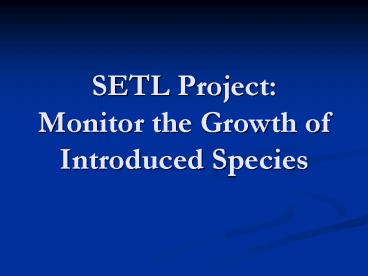SETL Project: Monitor the Growth of Introduced Species - PowerPoint PPT Presentation
1 / 29
Title:
SETL Project: Monitor the Growth of Introduced Species
Description:
SETL Project: Monitor the Growth of Introduced Species – PowerPoint PPT presentation
Number of Views:59
Avg rating:3.0/5.0
Title: SETL Project: Monitor the Growth of Introduced Species
1
SETL ProjectMonitor the Growth of Introduced
Species
2
Non-Native Species
- Hundreds of new species arrive in the United
States daily - Survive and force their way into the ecosystem
- These introductions are exponentially increasing
every year - Non-native species are the second largest cause
of biodiversity loss
3
- New introductions impact the environment,
fisheries, and economy - Some of the most widespread non-native species in
New England are colonial tunicates, green fleece,
and the Asian shore crab - These are currently displacing native species,
affecting their distribution and abundance - Introduced species create a waterfall effect that
creates unpredictable shifts in the basic
environment
4
What Can We Do?
- Due to the many aspects of introduced species
that cannot be predicted, it is important to know
more about them - We need to devise a method to determine the
number and distribution of the known introduced
species and monitor new introductions
5
Anemoon FoundationSETL Project
- Become part of a worldwide program initiated by
Adriaan Gittenberger to monitor the growth of
invasive species - By 2009 the project will be in effect in
temperate waters of every continent
6
Blue is 2007 Orange by 2008 Blue in 2009
For more information on this project, please
visit Anemoons website at http//www.anemoon.org/
setl
7
SETL Materials
- Brick with holes
- PVC plate
- Washing/clothing line
- Cable ties
- 2 long and 4 short
- Electric Sanding Device
- Scissors
- Pliers
- Measuring Tape
- Electric Drill
8
Steps 1-3
- Steps 1-3
- Roughen one side of the plate with sandpaper.
Drill 4 holes 3.3 cm (1.30 in.) and 5.5 cm (2.17
in.) from each corner (see diagram).
9
Steps 4-6
- Step 4
- Pull a short cable tie through each pair of
holes. (Use the pair of holes with a distance of
7.4 cm (2.91 in.) make sure the two loose ends
are not on the rough side of the plate). - Step 5
- Attach the two ends of each cable tie. (Do not
tighten them). - Step 6
- Place brick between the two cable ties.
10
Steps 7-10
- Place two short cable
- ties around each side
- of the attached cable
- ties, then thread each
- one through one
- holes of the brick to
- the other side, around the second
- cable ties and attach.
11
Steps 11-15
- Step 11
- Tighten all the cable
- ties with pincers to
- firmly attach the brick
- to the plate.
- Steps 12-15
- Cut away excess ends
- of cable ties.
12
Steps 16-18
- Steps 16-18
- Pull long cable ties through each top corner hole
of brick and thread both ties through one loop of
the line. Close the ties, but do not tighten.
13
Steps 19-23
- Steps 19-23
- Cut away excess ends of cable tie. Hide
connections of cable tie in holes of the brick.
14
Step 24
- Step 24
- Make sure the effective length between plate and
the top end of line is 1 m. (3.28 ft.).
15
Possible Attachments in the Field
Attached to harbor wall
16
Floating Dock
17
Steel Construction
18
(No Transcript)
19
What do we expect to find?
- Fouling organisms animals and plants that
attach to man-made structures like ships hulls
or docks - Early settlement organisms who are the first of a
succession of species - Natives, established introduced species, and
maybe new non-natives
20
Potential Fouling Organisms
- Barnacles Mussels
- Hydroids
http//a1410.g.akamai.net/f/1410/1633/7d/images.en
ature.com /seashore/seashore_m/SC0001_1m.jpg
http//www.climatechange.umaine.edu/Research/Exped
itions /2004/Greenland/blue-mussel.jpg
http//stellwagen.noaa.gov/education/adulted/image
s/invert_id/m-59.jpg
21
- Native
Seaweeds - Native Tunicates
-
Sugar Kelp
-
Laminaria saccharina - Sea
Grapes- Molgula manhattensis - Compound Sea Squirt Diplosoma listerianum
22
Introduced Species Most Likely to be Seen
- Tunicates
- Two types
- Solitary Tunicates
- European Sea Squirt
- Club Tunicate
- Colonial Tunicates
- Star Tunicate
- Orange or Red Sheath Tunicate
23
(No Transcript)
24
(No Transcript)
25
(No Transcript)
26
(No Transcript)
27
(No Transcript)
28
Seaweed
29
On the Lookout!Potential New Introduced Species































